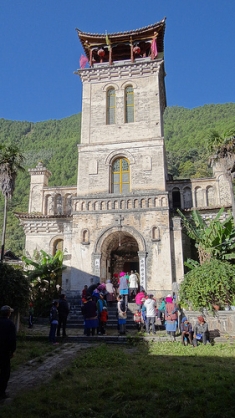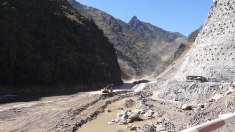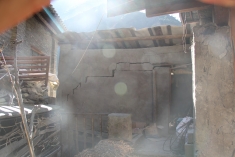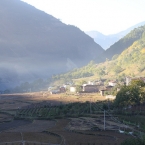Two Dams, Thousands Affected
Stories from the Lancang, Part 2
This is a guest blog by Songqiao Yao, International Rivers consultant. Read Part 1 of Stories from the Lancang.
When the bell struck 10 on a sunny Sunday morning, the sound of hymns sung in Tibetan filled the 100-year-old Catholic church in the tranquil village of Cizhong in Northwest Yunnan. The church was first built by French missionaries in the early 20th century, has experienced rule under both imperial and republic China, was almost destroyed in the Cultural Revolution, and is now managed by a priest from Inner Mongolia. By the entrance of the church, we sat chatting with a 70-year-old gentlemen who’d written a memoir documenting the church’s entire history of change and continuity.
Before mass, we had climbed to the top of the bell tower of the church. Spread below us were the fertile lands and beautiful Tibetan houses of Cizhong Village, located just west of the Lancang River and home to Tibetan farmers who have depended on the river for generations. Villagers harvest wheat, raise chickens, keep fish ponds, and grow walnut and apple trees further up the mountain. When the French missionaries arrived at the turn of the century, they had brought with them “rose honey” grape and taught the villagers how to make wine. Now almost every family makes and sells their own wine.
Cizhong will soon welcome some new guests into their village. These guests will occupy a portion of their hosts’ land, and like the villagers of Cizhong, they won’t have much of a choice in the process either. They are the current inhabitants of the soon-to-be-flooded town of Yanmen, above the 990 MW Wunonglong Dam on the Lancang River. Both hosts and guests will also receive an urban registration instead of a farming one, which means they will no longer have rights to farm the land. While official estimates put the number of relocated people at 808 (see Spreadsheet), the total number of affected peoples will be much higher.
A public notice at the entrance of Cizhong Village announces that no new construction is allowed in areas dedicated to the incoming relocated communities. When we asked villagers how they felt about the future newcomers to their village, they said that they were not in a position to say no to a government decision. They would prefer not to give up their precious farmland, but they are more afraid of the future conflicts that might arise because of the newcomers. However, they have not received any public notices confirming the relocation or been invited to participate in any informational briefings. Cizhong’s relatively high location saved it from being inundated, but each family will still feel the impact of Wunonglong Dam.
Inadequate Compensation Engendering Anger Among Farmers
A few kilometers upstream in the village of Huafengping, the impact of Wunonglong Dam feels much more immediate. As soon as Wunonglong Dam starts water impoundment, the village will be inundated. At a small pagoda by the edge of the village, some Tibetan farmers told us that they do not yet know where they will be moved. No one wants to leave their home and farmland. They have just harvested baskets of walnuts from their orchards up in the mountain, but they would have to give up everything – including access to these valuable crops – when they move.
After two days of driving to avoid a landslide that blocked the main road, we finally arrived at the Wunonglong Dam itself, We hired a small shuttle van to drive us to the dam site as our own jeep had broken down. The van driver, Mr. He Shenyan (a pseudonym), happened to be from Wunonglong Village. He told us his story on the bumpy road to the construction site as dirt and smoke from the construction crept into the van. His house and farm are located right where Wunonglong is being built. After the construction started, he lost his farm, but he has yet to receive any compensation for it. He told us that the public notice taped on a wall by the side of the village, which describes how much land each family had, was forged by the police. When surveyors came to measure the land, the measurements were significantly smaller than the actual size of the land. No family has received any compensation so far. Although the dam is only supposed to be built after ecological and immigration problems are properly resolved, the few remaining families in Wunonglong Village have to live their lives among the noise and dust emanating from the construction site next door.
Mr. He took us to see his house, which has started cracking as a result of the continuous construction and dynamiting at Wunonglong Dam. The roof, which was never stable to begin with, also has a few cracks and can no longer provide shelter when there is strong wind or rain. Compensation is supposed to be made according to the value of a villager’s previous house. However, villagers usually invest their money in the land and natural resources, rather than use it to improve their own living standards. Mr. He will have no chance of affording a new house in the new resettlement village, because it will be at least twice the value of his current house. For some, the situation is so bleak that they are willing to take violent measures to resolve such injustices – a situation that the government fears so much that it recently required all new large projects to undergo a social risk assessment. Most of Mr. He’s fellow villagers share the same sentiments: they would rather fight to keep their lands than move away.
Kept in the Dark
Foshan township, located further upstream at the border of Yunnan Province and the Tibetan Autonomous Region, has only two main streets surrounded by small businesses. Foshan and its neighboring village are home to roughly 3000 people. We sat down at a small restaurant to chat with the chef and restaurant owner. We asked whether they had heard about the news that they would have to move to make way for the Wunonglong reservoir. They said that no one knows exactly when the dam would be built and when they would have to move. The family has lived there for four generations and currently own orchards of apple and walnut trees. Holding his new-born baby, the restaurant owner said that shitake mushrooms and caterpillar fungus have also helped to bring in extra cash:
“We are dependent on the mountain and forests. We won’t have anything left if we move away.”

At the surveying office of Gushui hydroelectric station, we met an engineer from the Kunming Hydropower Design Institute. He had been in the dam industry for twenty years. According to him, Gushui Dam – which is currently awaiting the EIA process to start – will most definitely be built because the Lancang dams are a national development priority, while the environment is only a secondary concern. According to official estimates, over 3,700 people will be relocated for the project. Although China’s policies defend the rights of resettled communities and demand consideration of ecological and immigration issues before hydropower development, from the conversations we’d just had, those whose livelihoods depend on the rivers have been kept in the dark about their basic rights.
The Lancang River swerves through tall mountains and passes elegant villages and fertile fields that have grown along the river for centuries. Within this centuries-old scene, high up in the mountains, one can also see rigid rows of standardized houses – all with the same structure and color, and devoid of traditional cultural or ethnic heritage. These are the new resettlement villages. While these houses look new and colorful, they are just like a good policy without actual implementation – empty. Without fertile farmlands beside them, these new houses can never improve their inhabitants’ standard of living.
Stay tuned in the Spring for a comprehensive report on all the Yunnan dams on the Lancang River.
View a slideshow of photos from the Lancang and its people:
- View a map of all the dams on the Lancang
- For more information on the individual dams, as well as a list of all major dams on the Nu, Lancang, and Yangtze rivers in China, download the Spreadsheet of Major Dams in China









